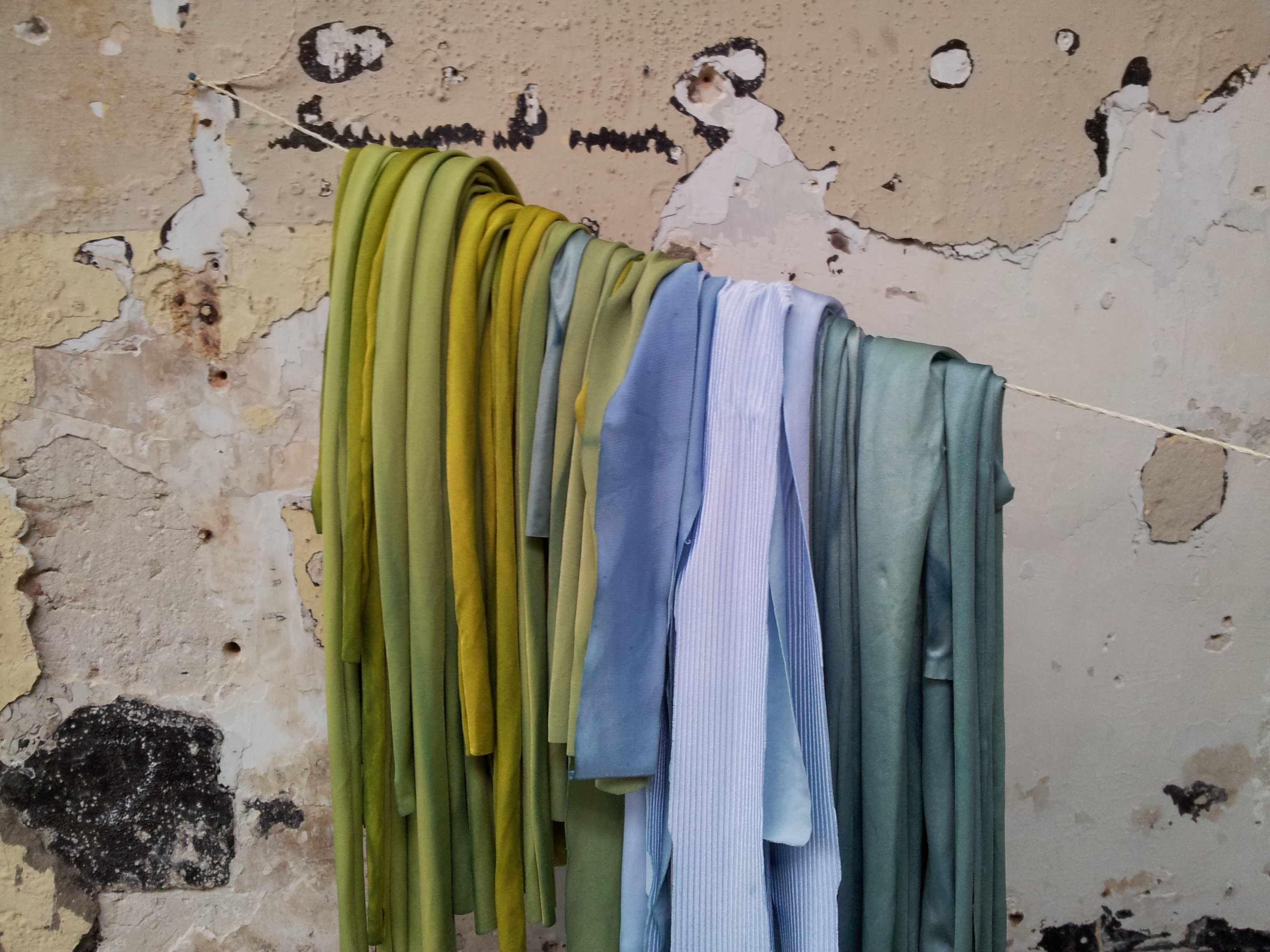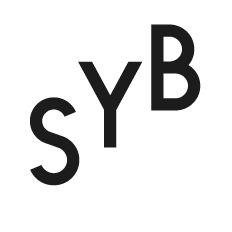28 March till 8 May 2012
ON RESIDENCY: AN (IN)VISIBLE PRODUCTION
Residency Angela Serino

Why do artists choose to do a residency? In what way does the structure of a residency differ from other existing supporting structures for artists, such as the gallery, the project space, the academy or the studio? How can a residency contribute to the development of the artists today? In the coming six weeks, these and other questions will be the focus of the programme ‘On Residency’, or the (in)visible production’, put together by independent curator Angela Serino.
The first two weekends of ‘On Residency’ will be marked by the design of a conceptual and material framework. Serino invited the Italian artist Paula Anziché to build her installation ‘Spaziando’, together with guests and visitors of Kunsthuis SYB. ‘Spaziando’ is a large and complex net of Lycra in which, during the programme, participants can move and nest themselves, as if it were a collective body. In the collective, physical interaction with the work, ‘Spaziando’ creates an environment in which new thoughts and ideas can be developed and exchanged.
A second recurring theme in the programme ‘On Residency’ is the reading group which assembles at different moments in Kunsthuis SYB. From a collection of texts, this reading group investigates which role a residency can play in artistic production. The residency is mainly approached as a break from daily routine, as a prerequisite for an investigation into conditions of work and the possibilities to find a better balance between living and working. The reading group consists of the artists’ collectives ADA (Rotterdam) and The Living Room(s) (Amsterdam), and additionally the visual artist Elsbeth Ciesluk and the art historian Suzie Hermán.
The progress of the investigation can be followed on the ‘weblog’. There, you can find the texts that the reading group discusses. For those who are interested, it is possible to participate in the programme in Kunsthuis SYB by contacting A.Serino or Kunsthuis SYB by e-mail of phone.
Angela Serino (1977,IT) is an independent curator. She graduated (cum laude) in Mass Communication at the University of Siena and moved to Amsterdam to attend the De Appel Curatorial programme in 2006. Since then she has curated several solo and group shows, in institutions and art organisations among which De Brakke Grond Amsterdam, Centraal Museum Utrecht, TENT. Rotterdam and European Cultural Foundation Amsterdam. In 2009 she curated RED A.i.R./Redlight Art Amsterdam initiated by the City of Amsterdam, De Key/Principaal, SMBA and Kunstenaars&CO. Since 2010, Angela Serino has been part of de programming committee of Kunsthuis SYB.
Paola Anziché (1975, IT) is an Italian artist, who lives and works in Turin. Paola studied at Accademia di Brera in Milan and graduated at Städelschule, Frankfurt am Main in 2004. She had solo shows at Fondazione Sandretto Re Rebaudengo and Fondazione Merz in Turin and was a finalist of the Talent Prize, Rome (2010). Anziché has been a resident at Cité Internationale Universitaire de Paris and at Capacete, Rio Janeiro/São Paulo, Brasil. http://www.paolanziche.net
ADA is an artists’ initiative that was founded in 2008. It has the goal to create, support and promote space for critical reflection and debate within the art world in an open, multidisciplinary and friendly environment. The core of ADA consists of six artists who live and work in Rotterdam: Maja Bekan, Deirdre M. Donoghue, Gerwin Luijendijk, Margo Onnes, Esmé Valk en Sjoerd Westbroek. http://www.adarotterdam.nl/about
The Living Room(s) is a collective of artists and cultural mediators from several different disciplines who are committed to social change, collective action and improvement of our daily way of life. The Living Room(s) does not have a home base, but is always being hosted by existing institutes, collectives and living rooms. It organises interventions in collaborations with performers, theorists and artists.http://livingroomamsterdam.wordpress.com/about/
Elsbeth Ciesluk (1986, Kampen) studied at the ArtEZ Academy for Art&Design in Zwolle and she is currently finishing her MA at AKV/St.Joost in Breda-Den Bosch. Elsbeth uses performances, texts, photography and video to shape her ‘obsessions for repetition and being a one man factory’. The artist was the winner of the Art Olive Award 2010. Her work has been shown at ‘A spectacle of consequences’, Duende, Rotterdam; ‘From the start to the beginning’, Lokaal 01, Antwerp, Belgium; ‘You are not here’, Kasteel het Nijenhuis Museum de Fundatie, Heino; ‘Art Olive Young Talent’, Westergasfabriek, Amsterdam, and as a publication in Kunstbeeld, ‘Brieven aan Roos van Put’. http://www.elsbethciesluk.com
Suzie Hermán (1986, Amsterdam) holds a BA in Art History (University of Amsterdam) and is currently attending the research master Art Studies (University of Amsterdam). During her studies she worked as an assistant curator for several art spaces and art projects. Amongst them are the Stedelijk Museum Bureau Amsterdam, RED A.i.R./Redlight Art Amsterdam, Artnews Projects (Berlin) and Nieuwe Vide, Haarlem (for ‘The Object Lag’). Recently she co-curated the exhibition ‘Grafisch Geluk’ in Museum Hilversum.
PROGRAMME
Sunday April 1, 2pm:
As a way to introduce the work of guest-artist Paola Anziché, we will screen ‘ Sur le traces di Lygia Clark’ a film on Lygia Clark by P. Anziché and I. Dionisio (Italy, 2011) 26 min.
Sunday April 8, 2pm:
The Reading Group at SYB: informal presentation of the reading sessions held at SYB by ADA and The Living Room(s).
Saturday April 28, 2pm:
On artists’ colonies, artists’ collectives and rural residencies. Lecture by prof. Andreas Schwab, historian and curator of Museo Casa Anatta, Monte Verità, Ascona (Switzerland), followed by a presentation of Maria Pask, ‘Re-reading Little Millet’.
More information on the programme: weblog
THE PRESENT MOMENT AND ONLY THE PRESENT MOMENT
by: Suzanne Rietdijk
translation: Jenny Wilson
The Now is. The Now cannot have passed or is still to come. It exists in favour of continuous replacement. We cannot remember nor imagine the Now. The only thing we can do is to alter the condition of the Now beforehand. The experience of the Now can be manipulated through intentional changes in time and space. It is this form of preconceived change that the curator Angela Serino has applied and researched during her working period at kunsthuis SYB. By giving people the opportunity to another state of being, Serino has created conditions for experiencing the now. Her residency is therefore not a working period in the sense of ‘work’ being a forming of or a striving towards an end product. It is an experience.
As a conclusion to her working period at SYB, Serino has organised a preconceived experience for her guests. This experience starts in the back room of SYB, where Paola Anzichè has installed a colourful net comprising pieces of lycra that are knotted together. The net is titled ‘Spaziando (seeing with the hands)’ and horizontally crosses through the space at chest height so that the visitor is forced to physically adjust to the newly formed spatial conditions. Only by walking bent down is the visitor able to move through this space. Furthermore, it is also possible to move your way up through the net at any given moment so that the elastic fabric network surrounds your body and you can play with the possibilities the material offers. By hanging onto or pulling it, everyone is able to manipulate the net, as well as the people finding themselves in it. An ‘action-reaction’ arises, where object, space and subject influence each other and are continually able to alter each other’s conditions.
Elsewhere in the space is a monitor displaying a group of people who, also with elastic materials, are collectively playing with the space and each other’s movements. It is a short video documentary about Lygia Clark and her workshops in Paris at the beginning of the 70’s. In this documentary, created by Anzichè, a shared reconstruction of this period is made from the memories of various eyewitnesses and several remaining video fragments. The video also shows where the installation ‘Spaziando’ took its roots from and directly places this installation in a historical context. As such, experiences of the now come together with moments from the past, and just like in the video documentary, freshly formed memories gain a new and almost imaginary charge.
The next moment in Serino’s compilation of experiences is the short performance by Elsbeth Ciesluk. By expressing her vocal range, Ciesluk shows the physicality of the performance. She is searching for extremes: from one that is very soft, to one that is very loud, to a vocal expression lasting as long as possible. Sometimes she claims the entire space through the sounds that she produces. But, when physical exertion finally breaks her voice and the loud scream slowly lapses into a fragile timbre she also shows the vulnerability of her own physical conditions.
In the last two moments that Serino has conditioned for the visitor, professor Andreas Schwab gives a short lecture about the historical anarchistic community that established itself in Monte Verità (Ascona) around 1900. This is followed by a collective mental exercise where tasks such as “recall the present moment and only the present moment” question aspects of the now, the bygone moment and memory versus the imagination.[1]
The start of Serino’s research relating to artist residencies is presented with this short sequence of experiences that she has put together in SYB. In the weeks prior to the final presentation several artists and artist collectives such as ADA (Rotterdam) and The Living Room(s) (Amsterdam) were invited as part of the reading group to jointly reflect on the phenomenon of ‘working periods’ through a collectively compiled reading list[2]. The aim of this was not to ultimately formulate answers to the questions posed. In the contrary, achievement as a goal was ruled out through the conditions that Serino had put to the reading group, and even laziness took on a positive value. Many new questions as well as new perspectives finally arose through this approach, allowing the subject to gain an increasingly wider significance.
Looking into the conditions to which artists are exposed during working periods, Serino and her reading group detected many similarities with our mutual attitude in relation to present society: both in residencies as well as in everyday life, people are subjected to the pressure to produce and to achieve. Although freedom should be a specific condition for a residency, it seems the realisation of working periods is in itself a demand that every serious artist subjects themselves to. According to Serino, this causes a forced hyper-mobility in which artists have to continually be on the move to allow their work to always be valid everywhere. The pressure enforced by the institutions concerned is huge and offers – in contrast to their hard-won ideologies – an incredibly directed work environment.
In spite of these discoveries, what Serino finally presents is not a solid, concluding message to current residency places. In the contrary, by means of historical references and examples, only a start has been made in researching both the conditions of artist residencies as well as society as a whole. To be able to carry out this research, theory was immediately put into practice. In an almost utopian work environment created by Serino, achievement is replaced by action and everyone has the space and freedom to bring a new interpretation to his/her experience. The ‘now’ of the action is more important than the future end result of the achievement. The process, the time between deed and consequence, takes centre stage. Yet, despite the preconceived manner of experience, what actually arises is a pleasant freedom in which no one is forced into anything in particular. Nothing is expected of the visitor, except perhaps a little time to be able to experience the new rhythm of the condition posed. In the small space of SYB the need to continually achieve is released for a moment so as to create new conditions for a Now in which even laziness is accepted.
